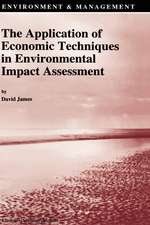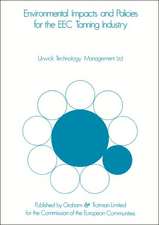Integrated Assessment of Running Waters in Europe: Developments in Hydrobiology, cartea 175
Editat de Daniel Hering, Piet F.M. Verdonschot, Otto Moog, Leonard Sandinen Limba Engleză Paperback – 9 oct 2012
| Toate formatele și edițiile | Preț | Express |
|---|---|---|
| Paperback (1) | 805.40 lei 38-44 zile | |
| SPRINGER NETHERLANDS – 9 oct 2012 | 805.40 lei 38-44 zile | |
| Hardback (1) | 955.25 lei 43-57 zile | |
| SPRINGER NETHERLANDS – 19 mai 2004 | 955.25 lei 43-57 zile |
Din seria Developments in Hydrobiology
- 18%
 Preț: 1229.10 lei
Preț: 1229.10 lei - 18%
 Preț: 959.98 lei
Preț: 959.98 lei - 18%
 Preț: 963.91 lei
Preț: 963.91 lei - 15%
 Preț: 648.24 lei
Preț: 648.24 lei - 15%
 Preț: 637.89 lei
Preț: 637.89 lei -
 Preț: 378.25 lei
Preț: 378.25 lei - 15%
 Preț: 644.95 lei
Preț: 644.95 lei - 18%
 Preț: 952.09 lei
Preț: 952.09 lei - 20%
 Preț: 558.87 lei
Preț: 558.87 lei - 18%
 Preț: 1833.65 lei
Preț: 1833.65 lei -
 Preț: 393.59 lei
Preț: 393.59 lei -
 Preț: 406.54 lei
Preț: 406.54 lei - 18%
 Preț: 1226.73 lei
Preț: 1226.73 lei - 18%
 Preț: 956.99 lei
Preț: 956.99 lei -
 Preț: 388.87 lei
Preț: 388.87 lei - 24%
 Preț: 1060.53 lei
Preț: 1060.53 lei - 18%
 Preț: 1229.28 lei
Preț: 1229.28 lei - 20%
 Preț: 569.31 lei
Preț: 569.31 lei -
 Preț: 368.79 lei
Preț: 368.79 lei - 24%
 Preț: 817.48 lei
Preț: 817.48 lei - 18%
 Preț: 958.25 lei
Preț: 958.25 lei - 18%
 Preț: 953.03 lei
Preț: 953.03 lei -
 Preț: 384.75 lei
Preț: 384.75 lei - 24%
 Preț: 1582.95 lei
Preț: 1582.95 lei - 24%
 Preț: 1051.70 lei
Preț: 1051.70 lei - 18%
 Preț: 943.57 lei
Preț: 943.57 lei - 18%
 Preț: 1235.76 lei
Preț: 1235.76 lei - 24%
 Preț: 800.05 lei
Preț: 800.05 lei - 24%
 Preț: 803.57 lei
Preț: 803.57 lei - 18%
 Preț: 948.29 lei
Preț: 948.29 lei
Preț: 805.40 lei
Preț vechi: 1059.73 lei
-24% Nou
Puncte Express: 1208
Preț estimativ în valută:
154.16€ • 167.51$ • 129.58£
154.16€ • 167.51$ • 129.58£
Carte tipărită la comandă
Livrare economică 16-22 aprilie
Preluare comenzi: 021 569.72.76
Specificații
ISBN-13: 9789401037617
ISBN-10: 9401037612
Pagini: 392
Ilustrații: IX, 379 p.
Dimensiuni: 195 x 260 x 21 mm
Ediția:Softcover reprint of the original 1st ed. 2004
Editura: SPRINGER NETHERLANDS
Colecția Springer
Seria Developments in Hydrobiology
Locul publicării:Dordrecht, Netherlands
ISBN-10: 9401037612
Pagini: 392
Ilustrații: IX, 379 p.
Dimensiuni: 195 x 260 x 21 mm
Ediția:Softcover reprint of the original 1st ed. 2004
Editura: SPRINGER NETHERLANDS
Colecția Springer
Seria Developments in Hydrobiology
Locul publicării:Dordrecht, Netherlands
Public țintă
ResearchCuprins
Overview and Application of the AQEM Assessment System.- Does the Ecoregion Approach Support the Typological Demands of the Eu ‘water Framework Directive’?.- Testing the European Stream Typology of the Water Framework Directive for Macroinvertebrates.- Comparing Macroinvertebrate Indices to Detect Organic Pollution across Europe: A Contribution to the EC Water Framework Directive Intercalibration.- Identification and Measure of Hydromorphological Degradation in Central European Lowland Streams.- Establishing Reference Conditions for European Streams.- A New Method for Assessing the Impact of Hydromorphological Degradation on the Macroinvertebrate Fauna of Five German Stream Types.- Assessing Acid Stress in Swedish Boreal and Alpine Streams Using Benthic Macroinvertebrates.- The Development of An Ecological Quality Assessment and Classification System for Greek Running Waters Based on Benthic Macroinvertebrates.- Detection of Organic Pollution of Streams in Southern Sweden Using Benthic Macroinvertebrates.- Towards a Multimetric Index for the Assessment of Dutch Streams Using Benthic Macroinvertebrates.- Assessment Methodology for Southern Siliceous Basins in Portugal.- Multimetric Assessment of Data Provided by Water Managers from Germany: Assessment of Several Different Types of Stressors with Macrozoobenthos Communities.- Assessment of Temporary Streams: The Robustness of Metric and Multimetric Indices under Different Hydrological Conditions.- A Stressor Specific Multimetric Approach for Monitoring Running Waters in Austria Using Benthic Macro-Invertebrates.- The Effect of Taxonomic Resolution on the Assessment of Ecological Water Quality Classes.- Integration of the Saprobic System into the European Union Water Framework Directive.- ‘Electronic Subsampling’of Macrobenthic Samples: How Many Individuals are Needed for a Valid Assessment Result?.- The AQEM Multimetric System for the Southern Italian Apennines: Assessing the Impact of Water Quality and Habitat Degradation on Pool Macroinvertebrates in Mediterranean Rivers.- Assessment of Organic Pollution Effect Considering Differences between Lotic and Lentic Stream Habitats.- The Effect of Excluding Taxa with Low Abundances or Taxa with Small Distribution Ranges on Ecological Assessment.- Characterising Hydromorphological Features of Selected Italian Rivers: A Comparative Application of Environmental Indices.

























